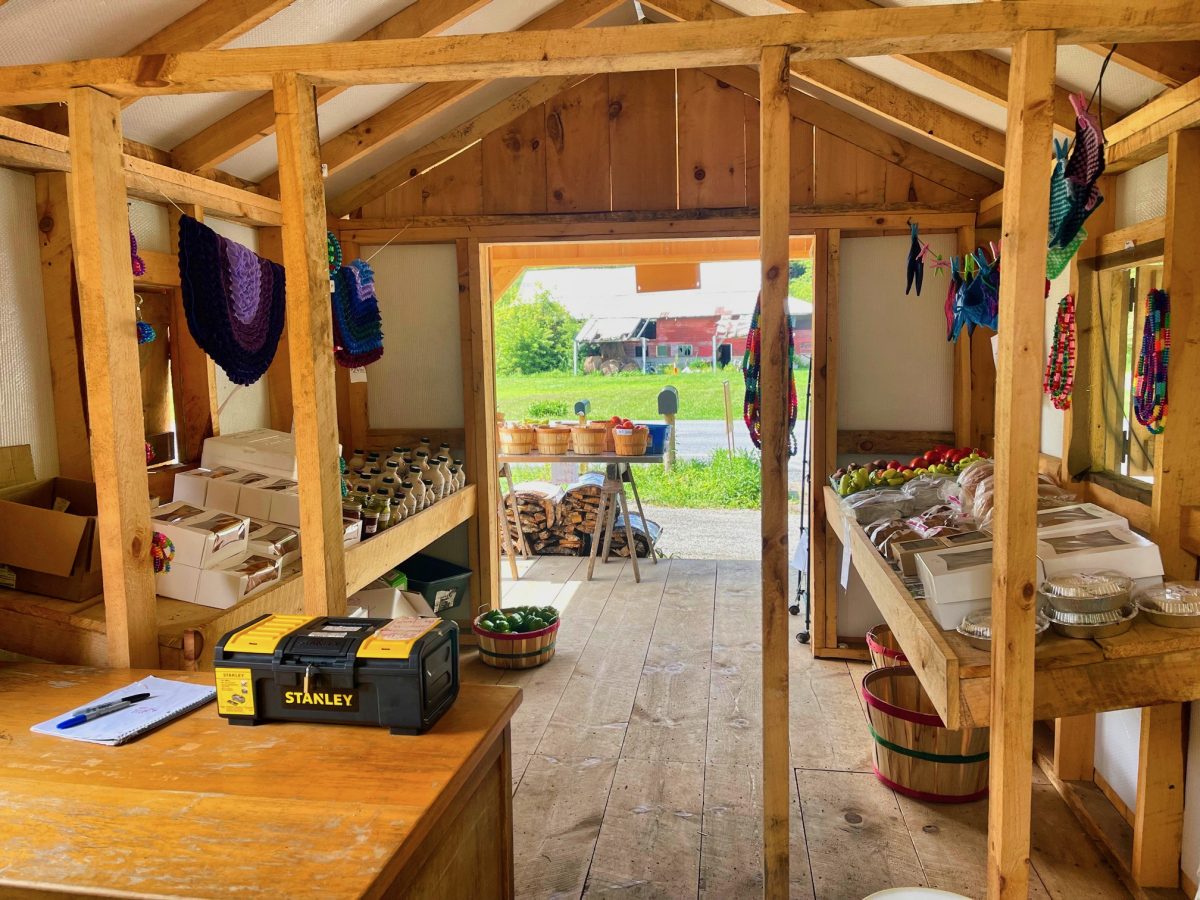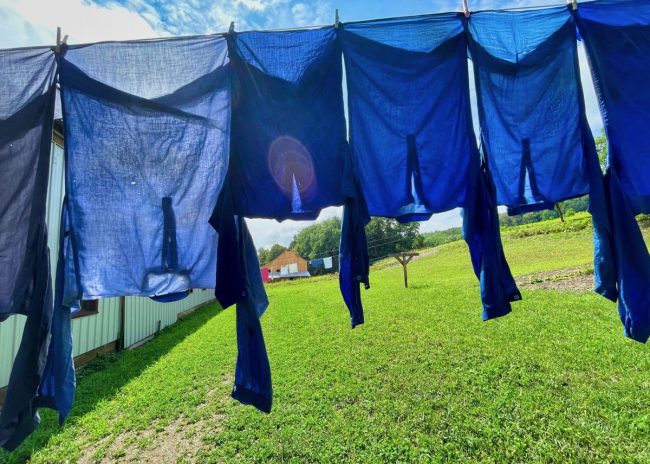I call it “Unconscious Amish Art.” I don’t know if it’s calculated or not, but the Amish I am seeing have an aesthetic that is apparent in almost everything they build, grow or make.
And although I call it “unconscious,” I doubt that it is.
The colors on the laundry line are especially beautiful and they often frame buildings and landscapes.
I see art almost everywhere I look, yet I almost never see it put together or set up. This happens while I am still sleeping.
What I am starting to see is that Amish Art is not articulated, or spoken about, but there is an aesthetic which I, as a photographer/artist, can see clearly. There is beauty in simplicity, from rows of vegetables in baskets to laundry on a line to the organization of a foodshed.
I am always reminded when I visit that I am an outsider, perhaps trusted but not one of them. They operate with a consciousness – and aesthetic – that is beyond me.
There is art and beauty in a simple carriage, which they refuse to adorn in any way, and in simple clothes, with appealing colors.
There is simplicity is the well-organized fruit and carrots and tomatoes.
There is simplicity and beauty in healthy children with no make-up or tattoos or rings or unhealthy skin.
I am understanding this as art, conscious or not, and they clearly have their own distinct aesthetic. Seeing them in their Sunday clothes riding to church while they sing is a beautiful image, all the more for its purity and simplicity. It feels like art to me.
When I first met the Millers, the shed sold pies and some occasional donuts. Today, when I saw the back door open and took this photo from inside, I was struck not only by the neatness and range of food and fruit and vegetables (maple syrup, carpets, and necklaces) but by the composition of the packages and rows of colorful vegetables in baskets.
There were more than a score of things for sale, all of them neatly and beautifully organized. Nothing seemed out of place and the products were in boxes that descended along a line.
I rarely want to take a photo of the inside of stores, I always want to take a photo of the inside of Amish buildings and greenhouses and sheds and barns.
As a rule, I don’t take any photos inside or if I am close to people of any age. When I do, I ask permission and show the results immediately. It’s a good system, it has worked out well for me, and, I hope, for them.
These things the Amish make and organize cry out to be photographed, and I am proud and pleased that I have won the trust of Moise and Barbara and am welcome to take a photo of this outside Amish art any time, as long as I don’t take close-ups of faces.
They are known for buggies and their clothes, but not for their art, which is natural, organic, and I believe, intuitive. And quite beautiful. They are keenly aware of lines, colors, shapes, and perspectives.
I’ve never seen any kind of Amish art in “English” museums.
I don’t really know how and if they plan these artistic details, I do know I could take 50 photos of the farm and each shot would show something neat, clean ironic, or artistic. Everything seems like a kind of sculpture, nothing is dashed together.
The Amish, for all their honesty, have lots of secrets, and they keep them to themselves and protect them. Their aesthetic is one of them.
There is a holistic quality to this art. And much thought and design somewhere along the line.
People who don’t want to be photographed create gorgeous land and art scapes almost instinctively. One always seems tied to the next.
They want to be seen, but not captured. They want to be a mystery but care about image. That is their identity.
The shed highlights food in rich colors, the pie boxes, and donut boxes are appetizing, lined up alongside each other neatly, the eyes can roam the shed and she everything in it, visible, and organized with size and shape in mine.
It never looks messy or poorly thought out, which makes it all the more appetizing.
The baskets are rarely empty, except at the end of the day when things are selling out.
Every laundry shot seems to frame the new barn. The horse buggies are lined up in a row, they look like a scene from a Willa Cather novel.
I buy something almost every time I’m in there.
I love taking clothesline photos there, for plain people, they are colorful and timeless. Nothing messy, dripping dirty, or wrinkled.
For people who live on a farm with no showers or hot running water, they are astonishingly neat. Farms are by nature messy and debris strewn, not Amish farms.
The green rows of their crops look like magazine covers, they are so green and red and straight and precisely lined up. There is a keen sense of how things look as well as how things are.
There is no detritus of an ordinary farm, no garbage or junk or boxes lying around.
Part of this, I think, is that the Amish culture is intact. We “English” have not invaded them or stolen their land, leaving them shattered and in search of their identity.
They have protected themselves from us and managed to stay mostly out of our way for 500 years. This plainness, this beauty is their own culture, not ours. I am just beginning to grasp it.
Traveling, I’ve seen Native-American reservations that are often a shambles, but pueblos that are beautiful and spotless. Their culture was destroyed and we have not been able to stuff them into ours.
This sense of anesthetic is the benefit of having reasons to come almost every day – to talk to Moise, deliver pans and boxes, bring ice cream or ice cubes. This wasn’t a conscious thing on my part, either, but it has touched the artist in me. You can’t see it if you come once in a while.
This is something I didn’t expect, but which enchants me. It also stimulates and inspires me, and is something I want to explore in my own work.
I’m in the company of fellow creatives when I visit the Millers, and perhaps this is part of what draws me to them.



So tell us what is in the bottles inside the store.
Maple Syrup
We have a gorgeous oak table we got in Lancaster PA from an Amish workshop. It was months from order to delivery and well worth the wait. It was delivered by a Mennonite fellow.
As always, thank you for the wonderful, insightful words you share with us. Attaching a link to another of my daily reads by Father Richard Rohr having to do with photography, hope you enjoy it
Richard Rohr’s Daily Meditation
From the Center for Action and Contemplation
Image Credit: Arthur Greenberg, In a Field (detail), 1973, photograph, Illinois, National Archives.
Week Thirty-Three: Finding God in the Arts
Receiving Images
Artist and author Christine Valters Paintner explores how we might reconsider traditional approaches to photography. Instead of “taking” pictures, she asks us to “receive” images similar to how we might welcome the presence of God in contemplation.
Contemplative practice is a receptive practice. We make ourselves available for grace to break in; we open ourselves to listen and ponder. . . .
We often use the word “take” to describe our relationship with photography. Our culture emphasizes taking time, taking what’s mine, and taking a break. What we are endeavoring to do in this process, however, is to receive (rather than take) the gifts around us, to be present enough so that, when the photographic moment arrives, we are able to receive it fully, with our whole hearts.
“Taking photos” is a common phrase, and changing that perception and process (especially if you use a smartphone, Lomo, or other disposable camera) may be hard to break, but I gently invite you to consider what reframing this process might be like for you and what it evokes in you. I invite you to bring a new awareness to how words and phrases can shape our experience and practices.
Rather than “taking” photos or “shooting” them or even “making” photos, we will practice “receiving” images as gift. The traditional words for photography are possessive and aggressive. Yet the actual mechanism of photography is that light is reflected off of a subject and received by the camera through the lens opening. We can create conditions for a “good” photo, but ultimately we must stand in a posture of receiving and see what actually shows up in the image.
The poet Rainer Maria Rilke [1875–1926] writes in one of his poems of “no forcing [and no] holding back.” [1] When we are receptive we let go of our agendas and expectations. We allow ourselves to see beneath preconceived ideas. Rather than going after what we want in life, or “forcing,” we cultivate a contentment with what actually is. Similarly, instead of “holding back” and merely observing life or falling asleep to it, we stay awake and alert, participating fully in its messiness and we keep our eyes open for the holy presence in its midst. Photographing in this way can become an act of revelation. One of the gifts of art in general, and photography in particular, is that the artist can offer others this vision of the graced ordinary moment.
[1] Rainer Maria Rilke, “I believe in all that has never yet been spoken,” in Rilke’s Book of Hours: Love Poems to God, trans. Anita Barrows and Joanna Macy, rev. ed. (Riverhead Books: 2005), 65.
Christine Valters Paintner, Eyes of the Heart: Photography as a Christian Contemplative Practice (Sorin Books: 2013), 29–31.
Image credit: Arthur Greenberg, In a Field (detail), 1973, photograph, Illinois, National Archives.
Image inspiration: The texture of this image inspires us to know this grass better by running our hands through and allowing it to tickle our fingertips. Likewise, when we create art, we experience an embodied knowing of God.
Tim, I was just getting ready to post this same meditation from Richard Rohr and then I saw that you beat me to it. 🙂 It’s a lovely perspective on the art of photography.
The inside of this wooden shed is absolutely art, Makes me want to buy something! Certainly your photo of it is art. Thank you for sharing it